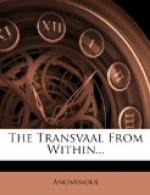its top being a bare rock (Bea. II.); thence to
the top of a rugged hill of considerable height falling
abruptly to the Komati River, this hill being the
northern extremity of the Isilotwani range, and separated
from the highest peak of the range Inkomokazi (a sharp
cone) by a deep neck (Bea. I.). (On a ridge in
the straight line between Beacons I. and II. is an
intermediate beacon.) From Beacon I. the boundary
runs to a hill across the Komati River, and thence
along the crest of the range of hills known as the
Makongwa, which runs north-east and south-west, to
Kamhlubana Peak; thence in a straight line to Mananga,
a point in the Libombo range, and thence to the nearest
point in the Portuguese frontier on the Libombo range;
thence along the summits of the Libombo range to the
middle of the poort where the Komati River passes
through it, called the lowest Komati Poort; thence
in a north by easterly direction to Pokioens Kop,
situated on the north side of the Olifant’s River,
where it passes through the ridges; thence about north-north-west
to the nearest point of Serra di Chicundo; and thence
to the junction of the Pafori River with the Limpopo
or Crocodile River; thence up the course of the Limpopo
River to the point where the Marique River falls into
it. Thence up the course of the Marique River
to ‘Derde Poort,’ where it passes through
a low range of hills, called Sikwane, a beacon (No.
10) being erected on the spur of said range near to,
and westward of, the banks of the river; thence, in
a straight line, through this beacon to a beacon (No.
9), erected on the top of the same range, about 1,700
yards distant from beacon No. 10; thence, in a straight
line, to a beacon (No. 8) erected on the highest point
of an isolated hill, called Dikgagong, or ‘Wildebeest
Kop,’ situated south-eastward of, and about
3-1/3 miles distant from a high hill, called Moripe;
thence, in a straight line, to a beacon (No. 7) erected
on the summit of an isolated hill or ‘koppie’
forming the eastern extremity of the range of hills
called Moshweu, situated to the northward of, and
about two miles distant from, a large isolated hill
called Chukudu-Chochwa; thence, in a straight line,
to a beacon (No. 6) erected on the summit of a hill
forming part of the same range, Moshweu; thence, in
a straight line, to a beacon (No. 5) erected on the
summit of a pointed hill in the same range; thence,
in a straight line, to a beacon (No. 4) erected on
the summit of the western extremity of the same range;
thence, in a straight line, to a beacon (No. 3) erected
on the summit of the northern extremity of a low,
bushy hill, or ‘koppie,’ near to and eastward
of the Notwane River; thence, in a straight line,
to the junction of the stream called Metsi-Mashware
with the Notwane River (No. 2); thence up the course
of the Notwane River to Sengoma, being the poort where
the river passes through the Dwarsberg range; thence,
as described in the Award given by Lieutenant-Governor
Keate, dated October 17, 1871, by Pitlanganyane (narrow




